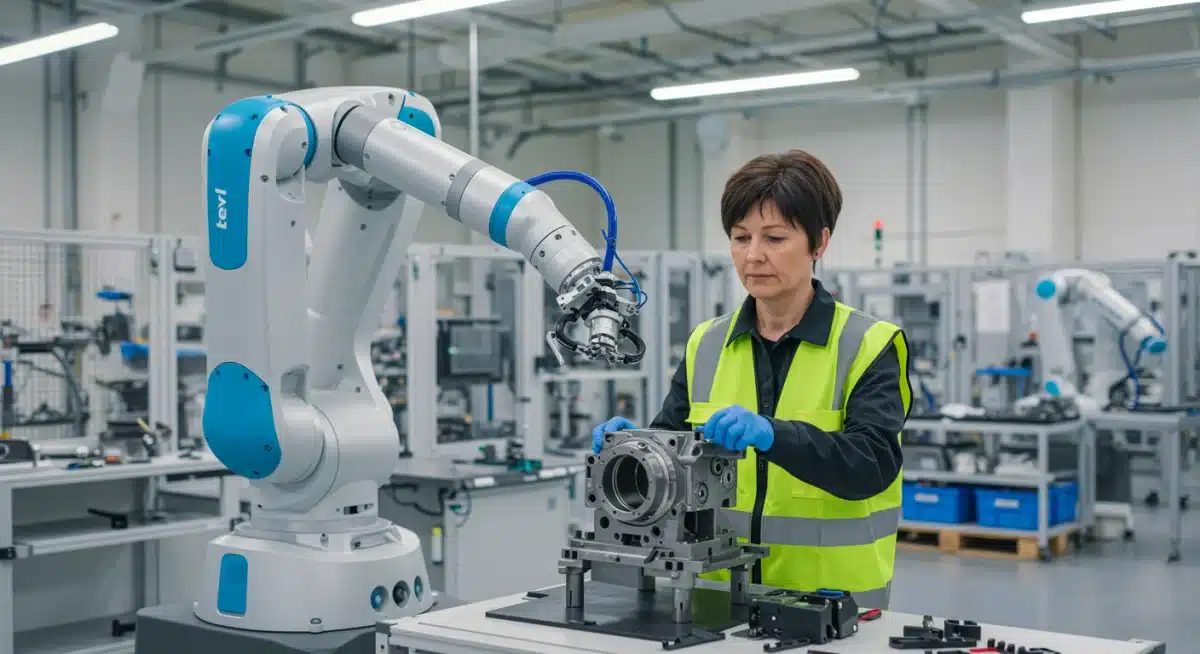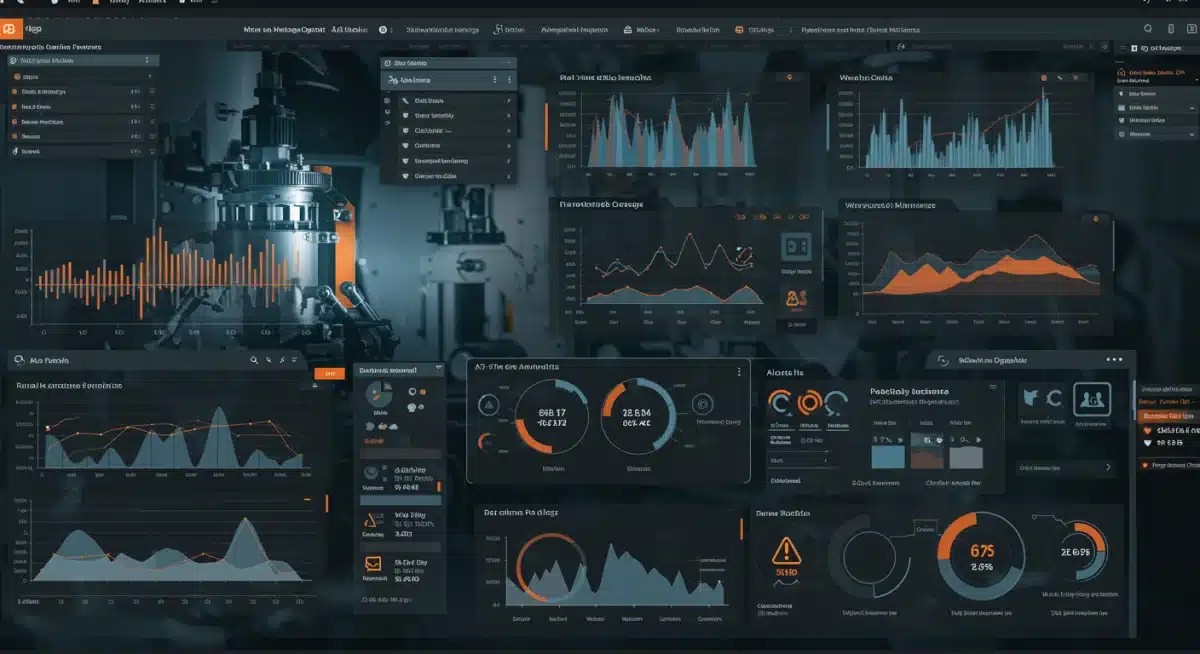Robotics in Manufacturing: 3 Practical Solutions for US Factories to Boost Productivity

US factories can significantly boost productivity by 20% this year through strategic implementation of robotics in manufacturing, focusing on automation of repetitive tasks, collaborative robot deployment, and advanced AI integration for optimized operations.
Are you a US factory owner or manager looking to significantly enhance your operational output? Unleashing the power of robotics in manufacturing offers a tangible pathway to increase productivity by a remarkable 20% this year, transforming challenges into unprecedented opportunities for growth and efficiency.
The imperative for robotics in US manufacturing
The landscape of manufacturing in the United States is undergoing a profound transformation. Facing global competition, rising labor costs, and the increasing demand for high-quality, customized products, US factories are under immense pressure to innovate. Robotics in manufacturing is no longer a futuristic concept but a present-day necessity for survival and growth. Integrating robotic solutions allows companies to address these challenges head-on, delivering consistent quality and optimizing production cycles.
Beyond the immediate production benefits, adopting advanced robotics also positions US manufacturers at the forefront of the Industry 4.0 revolution. This strategic shift not only boosts output but also fosters a culture of technological advancement, attracting skilled talent and securing a competitive advantage in the global market. The long-term implications extend to improved worker safety, reduced waste, and greater flexibility in adapting to market demands.
Addressing labor shortages and skill gaps
One of the most persistent issues plaguing the US manufacturing sector is the chronic shortage of skilled labor. Robotic systems can fill these gaps by handling repetitive, dangerous, or physically demanding tasks, freeing human workers to focus on more complex, value-added activities. This reallocation of human capital to roles requiring critical thinking, problem-solving, and creativity enhances overall workforce efficiency and job satisfaction.
- Reduces reliance on manual labor for mundane tasks.
- Allows human workers to upskill and take on supervisory or analytical roles.
- Mitigates the impact of an aging workforce and difficulty attracting new talent.
Enhancing precision and quality control
Robots excel at tasks requiring high precision and consistency, far surpassing human capabilities in repetitive actions. This leads to a significant reduction in errors, improved product quality, and less material waste. By automating critical steps in the production process, manufacturers can ensure every product meets stringent quality standards, thereby enhancing brand reputation and customer satisfaction.
The drive for increased productivity in US factories is inextricably linked to the strategic deployment of robotics. This initial investment paves the way for sustainable growth, operational resilience, and a stronger position in the global manufacturing arena. Understanding the foundational reasons for this shift is the first step toward realizing its immense potential.
Practical solution 1: Advanced automation for repetitive tasks
One of the most immediate and impactful applications of robotics in manufacturing is the automation of repetitive tasks. Many manufacturing processes involve operations that are monotonous, physically taxing, or require high consistency over long periods. These are prime candidates for robotic intervention, leading to significant gains in efficiency, accuracy, and employee well-being.
Advanced automation goes beyond simple pick-and-place robots. It encompasses sophisticated systems capable of performing a sequence of complex operations, such as welding, painting, assembly, and material handling, with unparalleled precision and speed. By offloading these tasks to robots, human workers can be redeployed to roles that require cognitive skills, supervision, or intricate problem-solving.
Streamlining assembly lines with robotic precision
Robotic arms are particularly adept at assembly tasks, where components need to be placed or joined with extreme accuracy. In automotive manufacturing, for instance, robots can perform intricate welding operations or install heavy parts with consistent force and alignment, tasks that would be difficult and fatiguing for human workers to maintain over an entire shift. This consistency reduces defects and rework, directly contributing to higher throughput.
- Ensures uniform product quality across all units.
- Increases assembly speed without compromising accuracy.
- Reduces the likelihood of human error in critical assembly steps.
Automating material handling and logistics
Moving materials, parts, and finished products throughout a factory floor is often a time-consuming and labor-intensive process. Automated Guided Vehicles (AGVs) and Autonomous Mobile Robots (AMRs) are transforming internal logistics. These robots can transport items efficiently between workstations, warehouses, and loading docks, optimizing flow and reducing bottlenecks. This not only speeds up the production cycle but also minimizes the risk of workplace injuries associated with manual lifting and transport.
The deployment of advanced automation for repetitive tasks is a cornerstone of boosting productivity in US factories. By strategically identifying and automating these processes, manufacturers can unlock substantial efficiencies, improve product quality, and create a safer, more dynamic work environment for their human workforce. This solution forms the bedrock of a modern, competitive manufacturing operation.
Practical solution 2: Collaborative robots (cobots) for human-robot synergy
While traditional industrial robots operate in cages for safety, collaborative robots, or cobots, are designed to work alongside human employees, sharing workspaces and tasks. This human-robot synergy represents a significant advancement in robotics in manufacturing, allowing factories to combine the precision and endurance of robots with the adaptability and problem-solving skills of humans. Cobots are typically smaller, lighter, and equipped with advanced sensors that enable them to detect and respond to human presence, ensuring safe interaction.
The integration of cobots allows for a more flexible production environment, particularly beneficial for small and medium-sized enterprises (SMEs) that may not have the capital or space for large-scale industrial automation. Cobots can be easily reprogrammed for different tasks, making them ideal for high-mix, low-volume production scenarios where flexibility is key. They augment human capabilities rather than replacing them entirely, leading to enhanced overall productivity.
Augmenting human skills with cobot assistance
Cobots excel at repetitive, ergonomic, or precise tasks that can be tedious or physically demanding for humans. For example, a cobot might hold a heavy part in place while a human worker performs an intricate assembly, or it could apply adhesive with consistent pressure and speed. This collaboration allows humans to focus on tasks requiring dexterity, judgment, or complex problem-solving, leading to a more efficient and less fatiguing workflow.
- Improves ergonomics and reduces strain on human workers.
- Enhances precision in tasks requiring both human and robot input.
- Increases production throughput by sharing workloads.

Flexible deployment and quick re-tasking
One of the key advantages of cobots is their ease of deployment and reprogramming. Unlike traditional robots that often require extensive engineering and safety infrastructure changes, cobots can be set up and taught new tasks relatively quickly. This flexibility means factories can adapt rapidly to changes in product designs, production volumes, or market demands without significant downtime or investment in new machinery. Their portability allows them to be moved between different workstations as needed, maximizing their utility.
Collaborative robots offer a compelling solution for US factories seeking to boost productivity by fostering a synergistic relationship between humans and machines. By leveraging cobots, manufacturers can achieve greater operational flexibility, improve worker safety, and enhance the overall efficiency of their production processes, making them a vital component in modern manufacturing strategies.
Practical solution 3: AI and machine learning for predictive maintenance and quality control
The third major practical solution for US factories looking to increase productivity by 20% lies in the integration of Artificial Intelligence (AI) and Machine Learning (ML) with their existing and new robotics in manufacturing systems. AI and ML capabilities elevate automation from mere task execution to intelligent, self-optimizing operations. These technologies enable predictive maintenance, advanced quality control, and real-time process optimization, preventing costly downtime and ensuring consistent product excellence.
By analyzing vast amounts of data collected from sensors on machinery, robots, and production lines, AI algorithms can identify patterns, predict potential failures, and suggest optimal operational parameters. This proactive approach minimizes unexpected breakdowns, extends the lifespan of equipment, and ensures that production runs smoothly and efficiently. The shift from reactive to predictive maintenance alone can save factories millions in repair costs and lost production time.
Predictive maintenance to minimize downtime
AI-powered predictive maintenance systems continuously monitor the health of machinery and robotic components. By analyzing vibration, temperature, sound, and other operational data, these systems can detect subtle anomalies that indicate impending failure. Maintenance can then be scheduled proactively during planned downtime, preventing catastrophic breakdowns and the associated production interruptions. This ensures a higher overall equipment effectiveness (OEE).
- Reduces unscheduled downtime by predicting equipment failures.
- Optimizes maintenance schedules, leading to cost savings.
- Extends the operational life of expensive machinery and robotic systems.
AI-driven quality inspection and defect detection
Traditional quality control often relies on manual inspection or basic automated checks, which can be prone to human error or miss subtle defects. AI-powered vision systems, combined with machine learning algorithms, can perform highly accurate and consistent quality inspections at speeds impossible for humans. These systems can identify miniscule defects, inconsistencies, or deviations from specifications, ensuring only perfect products leave the factory floor.
Furthermore, AI can learn from past data to understand the root causes of defects, allowing manufacturers to adjust production parameters in real-time to prevent future occurrences. This continuous feedback loop leads to a significant reduction in scrap rates and rework, directly contributing to increased productivity and cost savings.

Integrating AI and machine learning into manufacturing operations, especially in conjunction with robotics, is a game-changer for US factories. These intelligent systems provide the insights and foresight necessary to move beyond reactive problem-solving towards a truly optimized and highly productive manufacturing environment. This solution is crucial for any factory aiming for a 20% productivity increase this year and sustained growth.
Overcoming implementation challenges for robotics
While the benefits of integrating robotics in manufacturing are clear, the path to implementation is not without its challenges. US factories considering this transition must be prepared to address several key hurdles, including initial investment costs, the need for specialized skills, and the integration with existing legacy systems. Proactive planning and a phased approach can significantly mitigate these difficulties and ensure a smoother, more successful deployment.
The upfront capital expenditure for robotic systems, especially advanced ones, can be substantial. However, it’s crucial to view this as an investment with a high return, not just an expense. Many government incentives and financing options are available to help businesses adopt automation. Furthermore, the long-term savings in labor, reduced waste, and increased output often quickly offset the initial costs. Strategic financial planning is key to making these investments feasible for factories of all sizes.
Addressing the skill gap and workforce training
The introduction of robotics necessitates a workforce with new skills. Factory workers will need training in programming, operating, and maintaining robotic systems. This presents both a challenge and an opportunity. Companies must invest in upskilling their current employees through training programs, workshops, and certifications. Partnering with educational institutions and robot manufacturers can provide access to essential resources and expertise.
- Develop internal training programs for robot operators and maintenance technicians.
- Collaborate with local vocational schools and universities to build a talent pipeline.
- Focus on reskilling existing employees for higher-value roles in robot supervision and data analysis.
Seamless integration with existing infrastructure
Integrating new robotic systems with legacy machinery and IT infrastructure can be complex. Ensuring compatibility and seamless data flow between different systems is crucial for maximizing the benefits of automation. This often requires careful planning, custom software development, and potentially upgrading older equipment. A modular approach, where new robotic cells are gradually introduced and integrated, can help manage this complexity.
Overcoming these implementation challenges requires a comprehensive strategy that addresses financial, human, and technological aspects. By anticipating and planning for these hurdles, US factories can successfully deploy robotics in manufacturing, ensuring a smooth transition and realizing the promised productivity gains. The key is a commitment to continuous learning and adaptation throughout the integration process.
Measuring and sustaining productivity gains
Achieving a 20% increase in productivity through robotics in manufacturing is an ambitious but attainable goal for US factories. However, merely implementing robotic solutions is not enough; sustained success requires rigorous measurement, continuous optimization, and a commitment to adapting to new technologies. Establishing clear key performance indicators (KPIs) and regularly evaluating the impact of automation is crucial for validating investment and identifying areas for further improvement.
Productivity gains are not just about raw output numbers. They encompass a broader range of metrics, including reduced cycle times, improved product quality, lower operational costs, and enhanced worker safety. A holistic approach to measurement allows factories to understand the full scope of benefits derived from their robotic investments. Regular performance reviews and feedback loops are essential for fine-tuning robotic operations and ensuring they align with overarching business objectives.
Key performance indicators for robotic integration
To effectively measure the impact of robotics, factories should focus on several key metrics. These include overall equipment effectiveness (OEE), which combines availability, performance, and quality, as well as specific metrics like unit cost reduction, scrap rate, and lead time. Tracking these KPIs before and after robotic deployment provides tangible evidence of productivity improvements and helps justify further investments.
- Overall Equipment Effectiveness (OEE): A benchmark for manufacturing productivity, measuring how well a manufacturing operation is utilized.
- Unit Cost Reduction: The decrease in the cost to produce each individual item.
- Scrap Rate: The percentage of raw material that is wasted during the production process.
- Lead Time: The total time elapsed from the start to the completion of a production process.
Continuous improvement and future-proofing
The manufacturing landscape is constantly evolving, and so too must the approach to robotics. Sustaining productivity gains requires a culture of continuous improvement. This means regularly reviewing robotic processes, updating software, and exploring new robotic technologies as they emerge. Investing in R&D and staying abreast of industry trends ensures that factories remain competitive and continue to leverage the latest advancements.
Moreover, future-proofing involves designing robotic systems with scalability and adaptability in mind. This allows factories to easily expand or reconfigure their automated lines to accommodate new products, increased demand, or changes in manufacturing processes. A flexible and forward-thinking strategy ensures that the initial investments in robotics continue to deliver value for years to come.
Measuring and sustaining productivity gains from robotics in manufacturing is an ongoing process that demands attention to detail and a strategic vision. By focusing on relevant KPIs and embracing a mindset of continuous improvement, US factories can not only achieve their 20% productivity goal but also build a resilient and highly efficient manufacturing operation for the future.
The economic impact of robotics on US manufacturing
The integration of robotics in manufacturing within US factories extends beyond mere operational efficiency; it has a profound economic impact, revitalizing domestic production, creating new high-skilled jobs, and enhancing global competitiveness. By enabling factories to produce goods more efficiently and cost-effectively, robotics helps bring manufacturing back to the US, reducing reliance on overseas production and strengthening local economies. This shift contributes to national economic resilience and fosters innovation across various sectors.
The initial perception that robots replace human jobs is often countered by the reality that they transform the nature of work, leading to the creation of new, more specialized roles. These include robot programmers, maintenance technicians, data analysts for AI systems, and automation engineers. The demand for these skills drives educational and training initiatives, elevating the overall skill level of the workforce and increasing earning potential.
Boosting domestic production and reshoring efforts
Robotics provides US manufacturers with a significant advantage in terms of cost and quality, making domestic production more viable compared to offshore alternatives. This encourages reshoring, bringing manufacturing jobs and capital back to the United States. Increased domestic production strengthens supply chains, reduces geopolitical risks, and ensures greater control over product quality and intellectual property. The ability to produce goods competitively at home is a cornerstone of economic security.
- Reduces the cost differential between domestic and international manufacturing.
- Strengthens national supply chains and reduces dependency on foreign production.
- Creates opportunities for local economic development and job growth.
Catalyst for innovation and technological advancement
The adoption of robotics in manufacturing acts as a powerful catalyst for innovation. Factories that invest in automation are often driven to explore other advanced technologies like AI, IoT (Internet of Things), and advanced materials. This creates a virtuous cycle of technological advancement, pushing the boundaries of what’s possible in manufacturing and leading to the development of new products and processes. The US maintains its leadership in industrial innovation through these continuous technological leaps.
In essence, the economic impact of robotics on US manufacturing is overwhelmingly positive. It not only addresses immediate productivity concerns but also lays the groundwork for a more robust, innovative, and competitive industrial future. By embracing these technologies, US factories are not just optimizing their operations; they are actively shaping the economic landscape for generations to come, ensuring prosperity and leadership in the global arena.
| Key Solution | Brief Description |
|---|---|
| Advanced Automation | Automating repetitive tasks like assembly and material handling for increased speed and precision. |
| Collaborative Robots (Cobots) | Robots working safely alongside humans to augment skills, offering flexibility and reducing strain. |
| AI for Predictive Maintenance | Using AI to predict equipment failures and optimize maintenance, minimizing downtime and costs. |
| AI for Quality Control | AI-powered vision systems for highly accurate and consistent product inspection and defect detection. |
Frequently asked questions about robotics in manufacturing
The primary benefits include increased productivity, enhanced product quality, reduced operational costs, improved worker safety by automating hazardous tasks, and greater flexibility in production to meet market demands. It also helps address labor shortages and skill gaps prevalent in the industry.
Cobots boost productivity by safely working alongside human employees, taking on repetitive or ergonomically challenging tasks. This synergy allows humans to focus on complex problem-solving and decision-making, leading to faster workflows, reduced human error, and improved overall output without full automation.
AI optimizes robotics by enabling predictive maintenance, advanced quality control, and real-time process adjustments. AI algorithms analyze data from robots and machinery to anticipate failures, detect defects with high accuracy, and suggest optimal settings, thereby minimizing downtime and enhancing efficiency.
Key challenges include initial investment costs, the need to train or reskill the workforce for new robotic technologies, and integrating new systems with existing legacy infrastructure. Overcoming these requires strategic planning, financial incentives, and a commitment to continuous learning and adaptation.
Yes, a 20% productivity increase is achievable within a year through strategic and well-planned implementation of robotics. By focusing on automating key repetitive tasks, deploying collaborative robots, and leveraging AI for optimization, factories can realize significant gains in efficiency, quality, and throughput rapidly.
Conclusion
The journey toward a 20% productivity increase for US factories through robotics in manufacturing is not merely an aspiration but a tangible, achievable goal. By strategically implementing advanced automation for repetitive tasks, leveraging the collaborative power of cobots alongside human workers, and integrating AI for intelligent operations like predictive maintenance and quality control, manufacturers can unlock unprecedented levels of efficiency and competitiveness. While challenges in implementation exist, such as initial investment and skills gaps, these are surmountable with careful planning, robust training programs, and a commitment to continuous innovation. The economic benefits, including reshoring efforts and the creation of new high-skilled jobs, further underscore the imperative for US factories to embrace this technological evolution. The future of manufacturing is automated, collaborative, and intelligent, promising a more resilient and prosperous industrial landscape for the United States.





